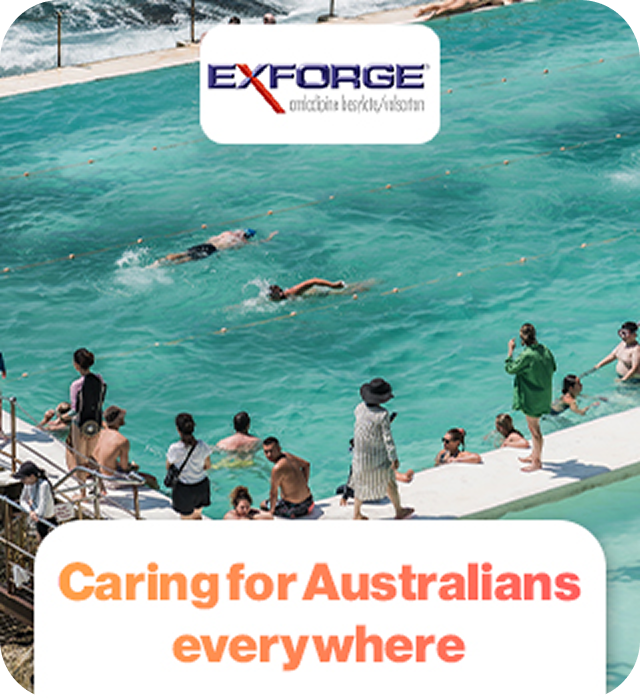

EXFORGE addresses Jillian’s* challenges to BP control
†BP control: <140/90 mmHg or <130/80 mmHg for diabetics3
‡72.7% of patients on EXFORGE 5/160 mg (±HCTZ) (95% CI 68.6–76.9)3
#74.8% of patients on EXFORGE 10/160 mg (±HCTZ) (95% CI 70.8–78.9)3
Footnotes and References
DIOVAN: In placebo-controlled trials in patients with hypertension (n=2,542) treated with DIOVAN (10–320 mg), the overall incidence of AEs was comparable with that of placebo.5 AEs with an incidence of ≥1% irrespective of causal association with DIOVAN: headache, dizziness, viral infection, upper respiratory tract infection, coughing, rhinitis, sinusitis, pharyngitis, diarrhoea, abdominal pain, nausea, fatigue, back pain, arthralgia.5
EXFORGE: In five controlled clinical studies including patients (n=2,613) treated with EXFORGE, AEs with an incidence of ≥1% were: nasopharyngitis, influenza, headache, oedema, pitting oedema, facial oedema, oedema peripheral, fatigue, flushing, asthenia, hot flush.2
a EX-FAST: Randomised, double-blind, multicentre study in patients with BP uncontrolled on monotherapy who were switched directly to amlodipine/valsartan 5/160 mg (n=443) or 10/160 mg (n=451). If BP was uncontrolled at week 8 (BP ≥140/90 mmHg or ≥130/80 mmHg in diabetics), open-label HCTZ 12.5 mg was added.3 If BP remained uncontrolled at week 12, HCTZ dose was increased to 25 mg (patients with controlled BP at week 8 but not at week 12 received HCTZ 12.5 mg).3 Primary efficacy endpoint was the proportion of patients with BP control (mean BP <140/90 mmHg in non-diabetic patients and <130/80 mmHg in diabetic patients) at the study endpoint (week 16). Peripheral oedema was the most frequent drug-related AE and led to discontinuation in 10 patients (2.3%) in the EXFORGE 5/160 mg group and in 41 patients (9.1%) treated with amlodipine/valsartan 10/160 mg.3
b Prospective, open-label, post-marketing surveillance study evaluating efficacy and safety of single-pill combination of amlodipine and valsartan in adults (n=8,336) with arterial hypertension (systolic BP >140 mmHg and/or diastolic BP >90 mmHg) in realworld clinical practice.4 Single-pill combination (SPC) amlodipine/valsartan 5/80, 5/160, or 10/160 mg once daily was prescribed and patients were observed over a 3-month period (12 weeks).4 The reason for prescription of SPC amlodipine/valsartan was specified for 8,287 patients: 43.4% were non-responders to previous monotherapy, 42.9% were non-responders to previous combination therapy, 9.6% could not tolerate previous therapy.4
Abbreviations: BP, blood pressure; CPAP, continuous positive airway pressure; HCTZ, hydrochlorothiazide; RAAS, Renin-Angiotensin-Aldosterone System; SPC, single pill combination.
References
- McEvoy JW et al. Eur Heart J. 2024; 45(38): 3912-4018.
- EXFORGE (amlodipine/valsartan) Australian approved Product Information.
- Allemann Y et al. J Clin Hypertens (Greenwich). 2008; 10(3):185–94.
- Karpov Y et al. Adv Ther 2012; 29: 134–147.
- DIOVAN (valsartan) Australian approved Product Information.
DIOVAN PBS Information: General benefit. This product is listed on the PBS as an angiotensin II antagonist.
EXFORGE PBS Information: Restricted benefit. Hypertension in a patient who is not adequately controlled with either an angiotensin II antagonist OR a dihydropyridine calcium channel blocker.
For DIOVAN prescribing information, please click here.
For EXFORGE prescribing information, please click here.
This content is intended for Australian healthcare professionals and is promotional.
